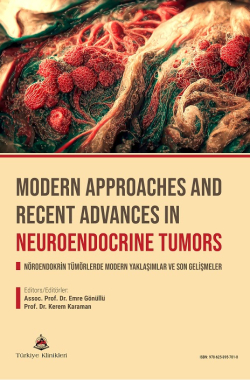GENERAL CHARACTERISTICS AND MANAGEMENT OF NEUROENDOCRINE TUMORS OF COLON AND RECTUM
Ahmet Tarık Harmantepe
Sakarya University Training and Research Hospital, Department of Gastroenterology Surgery, Sakarya, Türkiye
Harmantepe AT. General Characteristics and Management of Neuroendocrine Tumors of Colon and Rectum. In: Gönüllü E, Karaman K, editors. Modern Approaches and Recent Advances in Neuroendocrine Tumors. 1st ed. Ankara: Türkiye Klinikleri; 2025. p.145-151.
ABSTRACT
Neuroendocrine tumors (NETs) of the colon and rectum are rare but clinically significant malignancies originating from the neuroendocrine system. These tumors exhibit distinct biological behaviors based on their location, grade, and molecular characteristics. While colon NETs tend to be more aggressive and are diagnosed at advanced stages, rectal NETs are often smaller, better differentiated, and detected earlier. Diagnosis typically involves biochemical markers, imaging techniques, and histopathological analysis, including the Ki-67 proliferation index. Treatment approaches are determined by tumor grade, stage, and somatostatin receptor expression. Surgical resection is the cornerstone for localized tumors, while advanced cases may benefit from targeted therapies, somatostatin analogs, or peptide receptor radionuclide therapy (PRRT). Advances in molecular biology and genetics hold promise for personalized treatment strategies, while artificial intelligence may enhance diagnostic precision. This chapter provides a comprehensive review of the epidemiology, pathophysiology, clinical presentation, diagnostic methods, and treatment strategies for colon and rectum NETs, alongside future perspectives on improving patient outcomes.
Keywords: Neuroendocrine tumors; Colon; Rectum; Surgical procedure
Kaynak Göster
Referanslar
- Dasari A, Shen C, Halperin D, Zhao B, Zhou S, Xu Y, et al. Trends in the incidence, prevalence, and survival outcomes in patients with neuroendocrine tumors in the United States. JAMA Oncol. 2017;3(10):1335-42. [Crossref] [PubMed] [PMC]
- Yao JC, Hassan M, Phan A, Dagohoy C, Leary C, Mares JE, et al. One hundred years after "carcinoid": epidemiology of and prognostic factors for neuroendocrine tumors in 35,825 cases in the United States. J Clin Oncol. 2008;26(18):3063-72. [Crossref] [PubMed]
- Klimstra DS, Modlin IR, Coppola D, Lloyd RV, Suster S. The pathologic classification of neuroendocrine tumors: a review of nomenclature, grading, and staging systems. Pancreas. 2010;39(6):707-12. [Crossref] [PubMed]
- Pavel M, Öberg K, Falconi M, Krenning EP, Sundin A, Perren A, et al. Gastroenteropancreatic neuroendocrine neoplasms: ESMO Clinical Practice Guidelines for diagnosis, treatment and follow-up. Ann Oncol. 2020;31(7):844-60. [Crossref] [PubMed]
- Jiao Y, Shi C, Edil BH, de Wilde RF, Klimstra DS, Maitra A, et al. DAXX/ATRX, MEN1, and mTOR pathway genes are frequently altered in pancreatic neuroendocrine tumors. Science. 2011;331(6021):1199-203. [Crossref] [PubMed] [PMC]
- Modlin IM, Kidd M, Latich I, Zikusoka MN, Shapiro MD. Current status of gastrointestinal carcinoids. Gastroenterology. 2005;128(6):1717-51. [Crossref] [PubMed]
- Lloyd RV, Osamura RY, Klöppel G, Rosai J. WHO Classification of Tumours of Endocrine Organs. IARC Press; 2017.
- Glinicki P, Jeske W, Kapuścińska R, Zgliczyński W. Comparison of chromogranin A (CgA) levels in serum and plasma (EDTA2K) and the respective reference ranges in healthy males. Endokrynol Pol. 2015;66(1):53-6. [Crossref] [PubMed]
- Strosberg JR, Halfdanarson TR, Bellizzi AM, Chan JA, Dillon JS, Heaney AP, et al. The North American Neuroendocrine Tumor Society consensus guidelines for surveillance and medical management of midgut neuroendocrine tumors. Pancreas. 2017;46(6):707-14. [Crossref] [PubMed] [PMC]
- Spolverato G, Bagante F, Aldrighetti L, Poultsides GA, Bauer TW, Fields RC, et al. Management and outcomes of patients with recurrent neuroendocrine liver metastasis after curative surgery: An international multi-institutional analysis. J Surg Oncol. 2017;116(3):298-306. [Crossref] [PubMed]
- Caplin ME, Pavel M, Ćwikła JB, Phan AT, Raderer M, Sedláčková E, et al. Lanreotide in metastatic enteropancreatic neuroendocrine tumors. N Engl J Med. 2014;371(3):224-33. [Crossref] [PubMed]
- Yao JC, Phan AT, Jehl V, Shah G, Meric-Bernstam F. Everolimus in advanced pancreatic neuroendocrine tumors: the clinical experience. Cancer Res. 2013;73(5):1449-53. [Crossref] [PubMed]
- Raymond E, Dahan L, Raoul JL, Bang YJ, Borbath I, Lombard-Bohas C, et al. Sunitinib malate for the treatment of pancreatic neuroendocrine tumors. N Engl J Med. 2011;364(6):501-13. [Crossref] [PubMed]
- Lahner H, Mathew A, Klocker AL, Unger N, Theysohn J, Rekowski J, et al. Streptozocin/5-fluorouracil chemotherapy of pancreatic neuroendocrine tumours in the era of targeted therapy. Endocrine. 2022;75(1):293-302. [Crossref] [PubMed] [PMC]
- Kong G, Hicks RJ. PRRT for higher-grade neuroendocrine neoplasms: What is still acceptable? Curr Opin Pharmacol. 2022;67(102293):102293. [Crossref] [PubMed]
- Strosberg J, El-Haddad G, Wolin E, Hendifar A, Yao J, Chasen B, et al. Phase 3 trial of 177Lu-Dotatate for midgut neuroendocrine tumors. N Engl J Med. 2017;376(2):125-35. [Crossref] [PubMed] [PMC]
- Chan DL, Pavlakis N, Schembri GP. Dual Somatostatin Receptor/Positron Emission Tomography Imaging in the Management of Well-Differentiated Neuroendocrine Tumors. Clin Oncol (R Coll Radiol). 2017;29(12):770-6.
- Strosberg JR, Halfdanarson TR, Bellizzi AM. The North American Neuroendocrine Tumor Society (NANETS) guidelines: Well-differentiated neuroendocrine tumors of the stomach and rectum. Pancreas. 2010;39(6):735-52. [Crossref] [PubMed] [PMC]
- Parmar C, Grossmann P, Rietveld D, Rietbergen MM, Lambin P, Aerts HJWL. Radiomic machine-learning classifiers for prognostic biomarkers of head and neck cancer. Front Oncol. 2015;5:272. [Crossref] [PubMed] [PMC]

